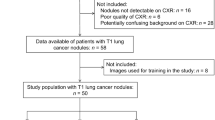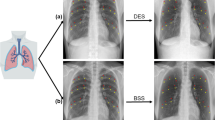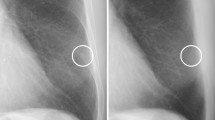Abstract
Objective
To evaluate radiologists’ ability to detect focal pneumonia by use of standard chest radiographs alone compared with standard plus bone-suppressed chest radiographs.
Methods
Standard chest radiographs in 36 patients with 46 focal airspace opacities due to pneumonia (10 patients had bilateral opacities) and 20 patients without focal opacities were included in an observer study. A bone suppression image processing system was applied to the 56 radiographs to create corresponding bone suppression images. In the observer study, eight observers, including six attending radiologists and two radiology residents, indicated their confidence level regarding the presence of a focal opacity compatible with pneumonia for each lung, first by use of standard images, then with the addition of bone suppression images. Receiver operating characteristic (ROC) analysis was used to evaluate the observers’ performance.
Results
The mean value of the area under the ROC curve (AUC) for eight observers was significantly improved from 0.844 with use of standard images alone to 0.880 with standard plus bone suppression images (P < 0.001) based on 46 positive lungs and 66 negative lungs.
Conclusion
Use of bone suppression images improved radiologists’ performance for detection of focal pneumonia on chest radiographs.
Key Points
• Bone suppression image processing can be applied to conventional digital radiography systems.
• Bone suppression imaging (BSI) produces images that appear similar to dual-energy soft tissue images.
• BSI improves the conspicuity of focal lung disease by minimizing bone opacity.
• BSI can improve the accuracy of radiologists in detecting focal pneumonia.




Similar content being viewed by others
References
Katz DS, Leung AN (1999) Radiology of pneumonia. Clin Chest Med 20:549–562
Vilar J, Domingo ML, Soto C, Cogollos J (2004) Radiology of bacterial pneumonia. Eur J Radiol 51:102–113
Trotman-Dickenson B (2003) Radiology in the intensive care unit (Part 1). J Intensiv Care Med 18:198–210
Trotman-Dickenson B (2003) Radiology in the intensive care unit (Part 2). J Intensiv Care Med 18:239–252
Schaefer-Prokop C, Neitzel U, Venema HW, Uffmann MU, Prokop M (2008) Digital chest radiography: an update on modern technology, dose containment and control of image quality. Eur Radiol 18:1818–1830
MacMahon H, Li F, Engelmann R, Robeerts R, Armato S (2008) Dual-energy subtraction and temporal subtraction chest radiography. J Thorac Imaging 23:77–85
Armato SG III, Doshi DJ, Engelmann R, Caligiuri P, MacMahon H (2006) Temporal subtraction of dual-energy chest radiographs. Med Phys 33:1911–1919
Szucs-Farkas Z, Patak MA, Yuksel-Hatz S, Ruder T, Vock P (2008) Single-exposure dual-energy subtraction chest radiography: detection of pulmonary nodules and masses in clinical practice. Eur Radiol 18:24–31
Kashani H, Varon CA, Paul NS et al (2010) Diagnostic performance of a prototype dual-energy chest imaging system: ROC analysis. Acad Radiol 17:298–308
Li F, Engelmann R, Doi K, MacMahon H (2008) Improved detection of small lung cancers with dual-energy subtraction chest radiography. AJR 190:886–891
Tsubamoto M, Johkoh T, Kozuka T et al (2002) Temporal subtraction for the detection of hazy pulmonary opacities on chest radiography. AJR 179:467–471
Kakeda S, Nakamura K, Kamada K et al (2002) Improved detection of lung nodules by using a temporal subtraction technique. Radiology 224:145–151
Loog M, Ginneken BV, Schilham AMR (2006) Filter learning: application to suppression of bony structures from chest radiographs. Med Image Anal 10:826–840
Suzuki K, Abe H, MacMahon H, Doi K (2006) Image-processing technique for suppressing ribs in chest radiographs by means of massive training artificial neural network (MTANN). IEEE Trans Med Imaging 25:406–416
Oda S, Awai K, Suzuki K et al (2009) Performance of radiologists in detection of small pulmonary nodules on chest radiographs: effect of rib suppression with a massive-training artificial neural network. AJR 193:886–891
Li F, Hara T, Shiraishi J, Engelmann R, MacMahon H, Doi K (2011) Improved detection of subtle lung nodules by use of chest radiographs with bone suppression imaging: ROC analysis with and without localization. AJR 196:W535–W541
Li F, Engelmann R, Pesce L, Doi K, Metz CE, MacMahon H (2011) Improved detection of small lung cancers by use of bone suppression imaging: comparison with dual-energy subtraction chest radiographs. Radiology 261:937–949
Metz CE, Herman BA, Shen JH (1998) Maximum-likelihood estimation of receiver operating (ROC) curves from continuously distributed data. Stat Med 17:1033–1053
Dorfman DD, Berbaum KS, Metz CE (1992) ROC rating analysis: generalization to the population of readers and cases with the jackknife method. Invest Radiol 27:723–731
Hillis SL, Berbaun KS, Metz CE (2008) Recent development in the Dorfman-Berbaum-Metz procedure for multireader ROC study analysis. Acad Radiol 15:647–661
Starr SJ, Metz CE, Lusted LB, Goodenough DJ (1975) Visual detection and localization of radiographic images. Radiology 116:533–538
Metz CE, Pan X (1999) “Proper” binormal ROC curves: theory and maximum-likelihood estimation. Math Psychol 43:1–33
Young M, Marrie TJ (1994) Interobserver variability in the interpretation of chest roentgenograms of patients with possible pneumonia. Arch Intern Med 154:2729–2732
Albaum MN, Hill LC, Murphy M et al (1996) Interobserver reliability of the chest radiograph in community-acquired pneumonia. Chest 110:343–350
Ojutiku O, Haramati LB, Rakoff S, Sprayregen S (2005) Radiology residents’ on-call interpretation of chest radiographs for pneumonia. Acad Radiol 12:658–664
Austin JHM, Romney BM, Goldsmith LS (1992) Missed bronchogenic carcinoma: radiographic findings in 27 patients with potentially resectable lesion evident in retrospect. Radiology 182:115–122
Monnier-cholley L, Carrat F, Cholley BP, Tubiana JM, Arrive L (2004) Detection of lung cancer on radiographs: receiver operating characteristic analysis of radiologists’, pulmonologists’ and anesthesiologists’ performance. Radiology 233:799–805
Li F, Arimura H, Suzuki K et al (2005) Computer-aided diagnosis for detection of missed peripheral lung cancers on CT: ROC and LROC analysis. Radiology 237:684–690
Shiraishi J, Pesce LL, Metz CE, Doi K (2009) On experimental design and data analysis in receiver operating characteristic (ROC) studies: lessons learned from papers published in RADIOLOGY from 1997 to 2006. Radiology 253:822–830
Acknowledgments
The authors are grateful to Alexandra Funaki, DO, Aswin Krishnamorthy, MD, Bin Jiang, MD, Ping Li, MD, Yonglin Pu, MD, Christopher Straus, MD, William Whetsell, MD, and Steven M. Zangan, MD for participating as observers; and to Charles E. Metz, PhD, for his critique and suggestions regarding ROC analysis. This work was supported in part by a research grant from Riverain Technologies. H. MacMahon is a shareholder of Hologic/R2 Technology, Inc., Los Altos, CA and a consultant for Riverain Technologies, Miamisburg, OH. F. Li, R. Engelmann, S.G. Armato, and H. MacMahon receive royalties through the University of Chicago for CAD technologies developed at the University of Chicago that have been licensed to R2 Technology (now Hologic), Deus Technologies, Riverain Medical, Mitsubishi Space Software Co., Median Technologies, General Electric Corporation, and Toshiba Corporation.
Author information
Authors and Affiliations
Corresponding author
Rights and permissions
About this article
Cite this article
Li, F., Engelmann, R., Pesce, L. et al. Improved detection of focal pneumonia by chest radiography with bone suppression imaging. Eur Radiol 22, 2729–2735 (2012). https://doi.org/10.1007/s00330-012-2550-y
Received:
Revised:
Accepted:
Published:
Issue Date:
DOI: https://doi.org/10.1007/s00330-012-2550-y




